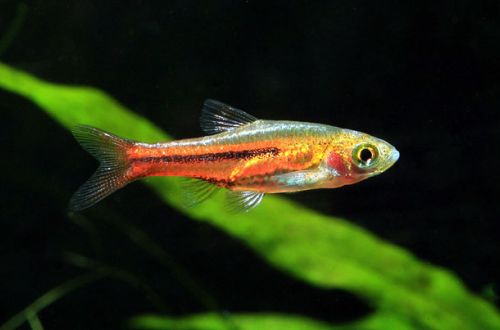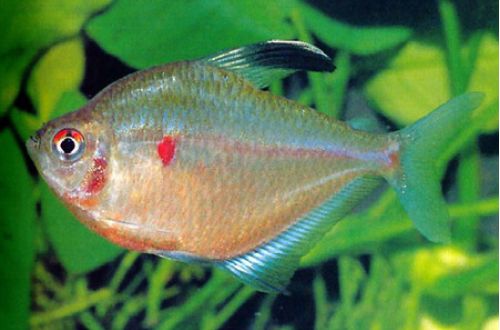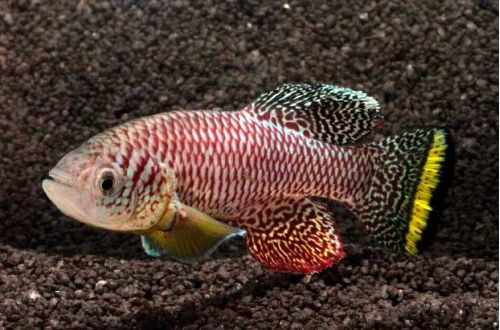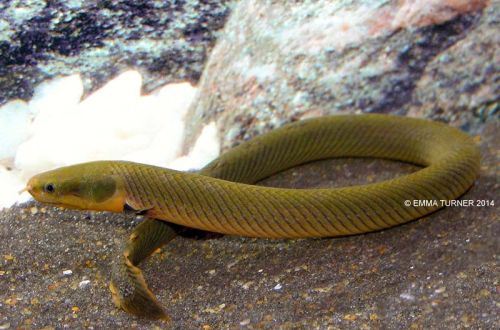
Rasbora somphongsi
Rasbora somphongsi, scientific name Trigonostigma somphongsi, belongs to the Cyprinidae family. Very rare fish both in the aquarium hobby and in nature. Until recently, they were considered extinct, until they were accidentally placed in Germany as part of the Rasbor party of a different kind. If you happen to purchase them, they will not cause big problems with the content. Unpretentious and have a peaceful disposition, can be recommended to beginner aquarists

Contents
Habitat
It comes from Southeast Asia from the territory of Thailand, and more precisely from its western province of Ratchaburi, near Bangkok. Perhaps the habitat was wider, however, by now this species has practically disappeared in the wild due to human activities.
The natural environment has been greatly altered by the construction of dams, which has altered the seasonal flooding patterns of parts of the rainforest. It is believed that the fish inhabited small forest channels, rapidly overgrown with aquatic vegetation from among the Cryptocorynes. The water had a brownish tint due to the abundance of decaying organic matter – leaves, branches, fruits, etc.
Brief information:
- The volume of the aquarium – from 40 liters.
- Temperature – 22-26°C
- Value pH — 5.0–7.0
- Water hardness – soft (1-8 dGH)
- Substrate type – any
- Lighting – subdued / moderate
- Brackish water – no
- Water movement – weak or stagnant
- The size of the fish is 2-3 cm.
- Food – any food
- Temperament – peaceful
- Keeping in a group of 8-10 individuals
Description
Adults reach a length of about 3 cm. The color is copper-red or yellowish with a black stripe stretching from the middle of the body to the tail. Fins and tail are transparent. Sexual dimorphism is weakly expressed. Males have more saturated colors, but are inferior to females in size.
Food
Not picky about the diet. In a home aquarium, it will accept most popular foods of a suitable size (dry, live, frozen). It is desirable to purchase high-quality products rich in protein, which favorably affects the tone of the fish and contributes to the manifestation of a better color.
Maintenance and care, arrangement of the aquarium
The optimal volume of the tank for a small flock of fish starts from 60 liters. When choosing a design, it is advisable to give preference to an aquarium with a large number of shade-loving plants, snags, etc., imitating the natural habitat. The lighting is subdued. Adding dried leaves will give the water a characteristic brownish tint.
Maintenance of an aquarium with Rasboras somphongsy is standard. It is necessary to regularly clean the soil and decor, replace part of the water with fresh water, control nitrate levels and maintain the necessary hydrochemical indicators.
Behavior and Compatibility
A schooling peaceful fish, it gets along well with other non-aggressive fish of a comparable size. No intraspecific conflicts were noted. It is advisable to keep at least 8–10 individuals in a group, with a smaller number they become shy and tend to hide, especially in a company with large neighbors.
Breeding / breeding
Due to the disappearance of this species from the wild, their breeding in aquariums begins to take on a special meaning. In addition, this process is not so complicated. Like other representatives of cyprinids, in favorable conditions Rasbora somphongsi will spawn regularly.
With the onset of the mating season, the fish attach their eggs to the surface of wide leaves and no longer participate in the care of their offspring and can even eat them on occasion. The incubation period lasts 1-2 days depending on the temperature. In the general aquarium, the survival rate of fry will be quite low, they become victims of their own parents and other fish, and also die from lack of food.
If you plan to save the entire brood (most of it), then the eggs should be transferred in a timely manner to a separate tank with identical water conditions. Then the hydrochemical parameters should be slowly brought to the following values: pH 5.0–6.0 and 1–5 dGH. In the design, thickets of mosses and ferns are used. The lighting is subdued. Of the equipment, a heater and a simple airlift filter with a sponge are enough. Juveniles are fed with microfoods (powdered), or, if possible, brine shrimp nauplii.
Fish diseases
In a balanced aquarium biosystem with suitable water conditions and regular maintenance, fish health problems usually do not occur. Illnesses can be the result of improper care or injury. Read more about symptoms and treatments in the Aquarium Fish Diseases section.





